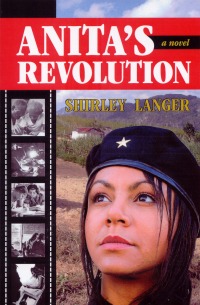| ________________
CM . . .
. Volume XIX Number 26. . . .March 8, 2013
excerpt:
In January of 1959, Fidel Castro became the prime minister of Cuba, leading a revolution that would redefine the Cuban economy and challenge the Cuban people to forego racial discrimination, private ownership of land and private enterprise. 1961 found Castro determined to wipe out illiteracy. He recruited thousands of middle class teenagers to become teachers (brigadistas) and sent them out to transform the lives of the poorest Cubans. In Anita's Revolution, 15-year-old Anita takes up Castro's challenge. Leaving the comforts of a well-off, loving home, Anita is sent into the countryside to teach Ramon, his wife Clara and her sister Zenaida how to read and write. But first of all she has to gain their trust by joining in the day-to-day life of these poor people. Anita looks after pigs and chickens and beats laundry on the rocks of a nearby river. In spite of her pupils' trepidation (not to mention their exhaustion), Anita manages to begin lessons, instill confidence and shepherd her small group through the first of three tests. Counter-revolutionaries are active in the region, threatening the brigadistas, and finally Anita is kidnapped by them. Rescued after four terrifying days, Anita stays on until she has finished the teaching and can proudly fly the flag of literacy from the Perez home. At the end of the year, all the teachers enter Havana on a special train for a massive celebration, and Anita returns home to her anxious family. Anita is a strong character, clearly caught up in revolutionary teenage fervour and determined to make a difference in the new Cuba. At the same time, she is unsure of herself and loves her protective parents dearly, finally persuading them to sign her consent form by inviting over an influential neighbour, Marjorie, who is taking her own daughters to the countryside to teach. Anita uses her brief teacher training and tools well but also adapts her lessons so the family will engage in them willingly. She endures vicious heat, hard manual labour, and the premature birth of Clara's daughter, and she begins to realize how privileged her own family is. Anita moves from a sweet, somewhat spoiled girl to a thoughtful, inspired young woman who is committed to building a new Cuba. Secondary characters, especially Ramon, Clara and Zenaida, are well-rounded and poignant. Ramon's sense of humour and his determination despite his age, Clara's commitment despite her motherly duties, and Zenaida's switch from sullen scorn to enthusiastic learner will keep readers' attention. The confidence and enthusiasm of Marjorie and the other brigadistas is inspiring. Readers will find the numbers of people who became literate in such a short few months to be astounding, and the brigadistas' achievement will bring the intended readers to tears. The action is nonstop but interspersed with many letter and diary entries which advance the plot well and enrich the characters. Spanish phrases are well integrated and easy to understand, adding authenticity and colour. As worthy as elements of the story are, I cannot imagine a child wanting to read this novel, and I am not sure how much one would learn from reading it. I suppose it could be used as a way to talk about neglect and abuse, about the difficulties of being a foster child, and how difficult it is for neglected children to find a voice. There are nine pages of old photos that illustrate clearly the primitive conditions the brigadistas endured. A map and a brief history of Cuba will clarify for the reader the background of the story. It's unfortunate that the image of a brigadista on the front cover of the book portrays a much older woman heavily made up, when Anita is a young 14-15-years-old, especially when this novel emphasized the primitive conditions endured by the brigadistas. Make-up would not have been part of it! This historical novel will inspire and enthral young readers who want to make a difference in society. Recommended. Joan Marshall is a Winnipeg, MB, bookseller.
To comment
on this title or this review, send mail to cm@umanitoba.ca.
Copyright © the Manitoba Library Association. Reproduction for personal
use is permitted only if this copyright notice is maintained. Any
other reproduction is prohibited without permission.
NEXT REVIEW |
TABLE OF CONTENTS FOR THIS ISSUE
- March 8, 2013
AUTHORS |
TITLES |
MEDIA REVIEWS |
PROFILES |
BACK ISSUES |
SEARCH |
CMARCHIVE |
HOME |
